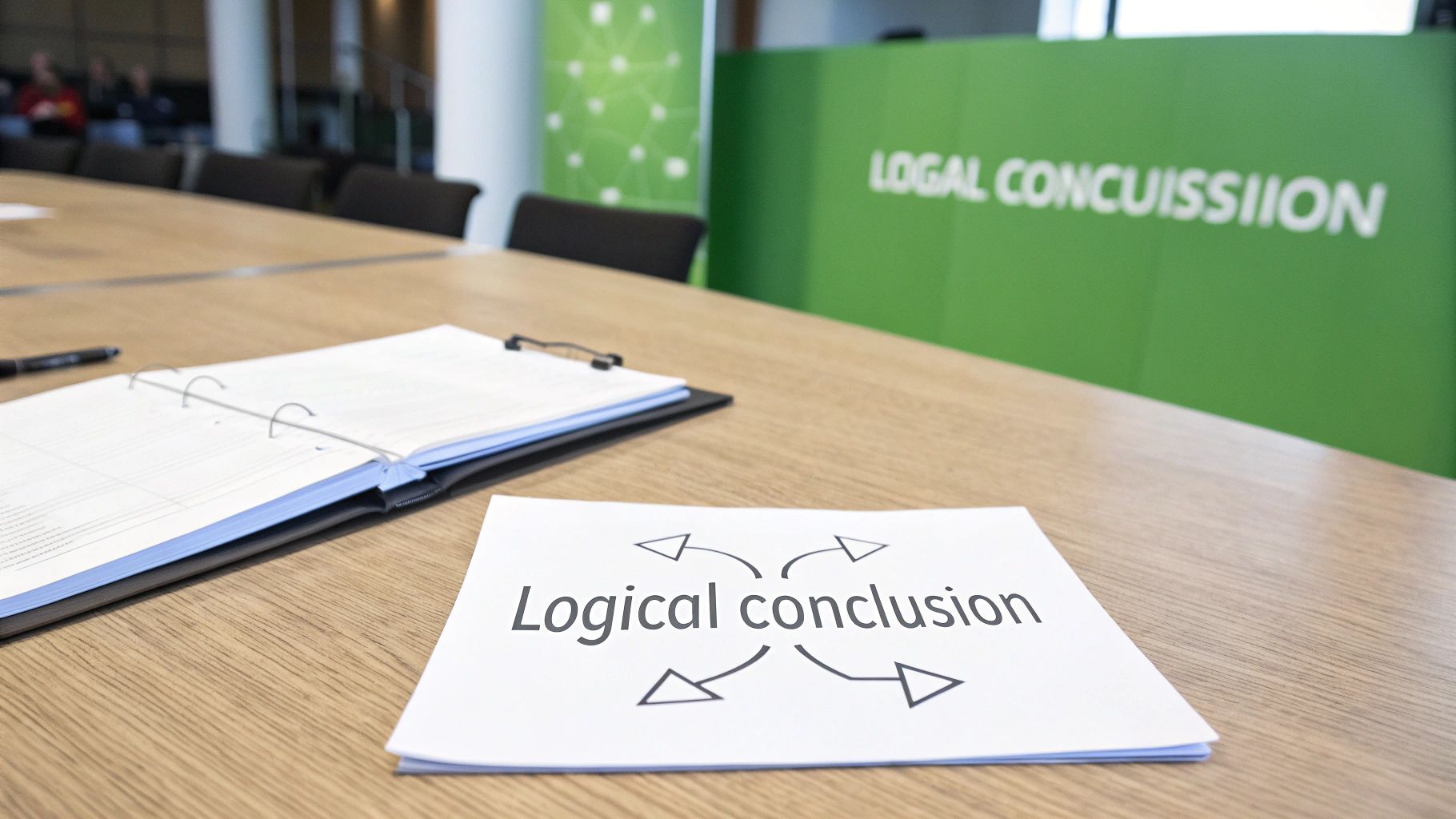
10 Powerful Endings with good concluding transition words
November 22, 2025
The conclusion is your final opportunity to persuade, inform, and leave a lasting impression on your reader. Yet, many writers find it challenging to shift smoothly from their main arguments to a powerful final statement. The secret to a seamless ending often lies in a single, well-chosen transition. Standard phrases like ‘in conclusion’ can feel repetitive and robotic, particularly as AI-generated text becomes more common. A weak transition can signal an abrupt, unsatisfying end, undermining the hard work you put into the body of your text.
This guide moves beyond the basics, offering a comprehensive roundup of good concluding transition words and phrases tailored for various contexts. We will dissect the specific tone, appropriate usage, and unique impact of each option, from the formal to the conversational. You won't just get a list; you'll get a practical toolkit complete with actionable examples and formatting tips to help you craft endings that are as compelling as your arguments. To ensure your content captivates your audience from start to finish, understanding why your final words matter most can be further enhanced by exploring strategies for creating engaging content.
Whether you are a student refining an academic essay, a marketer optimizing a campaign, or a blogger looking to enhance your posts, mastering these transitions is crucial. This listicle is designed to help you transform your conclusions from simple afterthoughts into memorable, impactful takeaways. We will explore how to select the perfect concluding phrase to summarize evidence, issue a powerful call to action, or offer a final, thought-provoking reflection.
1. In conclusion
The phrase "in conclusion" is perhaps the most traditional and widely recognized of all concluding transition words. It functions as a direct and unambiguous signal to the reader that you are about to summarize your main arguments and bring the discussion to a close. Its formality makes it a reliable choice for contexts where clarity and structure are paramount.
This phrase explicitly delineates the conclusion from the body of the text, leaving no room for confusion. It sets a formal, academic tone and prepares the audience for a final synthesis of the information presented.

When to Use "In conclusion"
This phrase is most effective in highly structured and formal writing. Its straightforward nature lends authority and finality to your work, making it one of the most dependable good concluding transition words for specific documents.
Consider using it for:
- Academic Essays and Research Papers: It clearly marks the final section where you restate your thesis and summarize findings.
- Business Reports and Formal Presentations: It provides a clear transition into final recommendations or a summary of key performance indicators.
- Legal Documents and Official Statements: Its formality is appropriate for documents requiring precision and a clear structure.
Practical Tips for Implementation
While effective, "in conclusion" can sometimes feel overly conventional or stiff in less formal contexts. To use it successfully, follow these guidelines:
- Use It Sparingly: This phrase should appear only once, at the very beginning of your concluding paragraph. Overuse diminishes its impact.
- Follow with a Comma: Always place a comma after "in conclusion" before proceeding with the rest of your sentence. For example: “In conclusion, the data overwhelmingly supports the initial hypothesis.”
- Avoid in Creative or Informal Writing: In blog posts, narrative essays, or marketing copy, it can sound robotic. Opt for a more natural transition unless you are aiming for an intentionally formal or ironic tone.
Pro Tip: If your writing has a contemporary or conversational voice, consider alternatives like "to sum up" or "ultimately" to maintain consistency. Using "in conclusion" in a casual article can create a jarring shift in tone for the reader.
Mastering the conclusion itself is just as important as the transition into it. To refine your entire final paragraph, you can find helpful strategies on how to write an effective conclusion on NaturalWrite's blog.
2. To summarize
The phrase "to summarize" is a direct and functional transition that signals a concise recapitulation of the main points. Unlike the more formal "in conclusion," it carries a slightly more practical and instructional tone, focusing on the act of condensing information for clarity and reinforcement.
This transition explicitly tells the reader that the following sentences will distill the core arguments or key takeaways from the preceding text. It is less about bringing the piece to a grand, formal close and more about ensuring the reader has grasped the most critical information presented.
When to Use "To summarize"
This phrase excels in contexts where brevity and clarity are the primary goals of the conclusion. Its utilitarian nature makes it a strong choice for informational or educational content, serving as one of the most effective good concluding transition words for knowledge-based writing.
Consider using it for:
- Educational Presentations and Lectures: It’s a perfect verbal or written cue before a recap slide or final review of the lesson's main ideas.
- Technical Documentation and Manuals: It helps users quickly find a condensed version of instructions or findings.
- Business Meeting Summaries: It effectively introduces the bulleted list of key decisions and action items discussed.
- Scientific Abstracts and Research Summaries: It clearly signals the condensation of complex research into its essential findings.
Practical Tips for Implementation
While "to summarize" is highly useful, its directness requires careful placement to avoid sounding abrupt. To implement it effectively, keep these tips in mind:
- Pair with Lists: This phrase works exceptionally well when followed by a bulleted or numbered list. This visual structure reinforces the idea of a condensed summary.
- Follow with a Comma: Like its formal cousin, "to summarize" should be followed by a comma. For example: “To summarize, the key factors are cost, accessibility, and user support.”
- Combine for Clarity: Enhance its function by combining it with other phrases for a smoother flow. For instance: “To summarize, the main points discussed are…” or “To summarize our findings, we identified three primary outcomes.”
Pro Tip: In a verbal presentation, use the phrase "So, to summarize..." as a natural-sounding verbal cue. This conversational softener signals to your audience that you are shifting into your final recap, helping them refocus their attention on the most important takeaways.
3. In summary
The phrase "in summary" offers a slightly less formal yet equally effective alternative to "in conclusion." It acts as a clear and efficient signal that you are about to condense the main points of your discussion. Its versatility makes it a perfect middle ground, suitable for professional communication that requires clarity without the rigid formality of academic writing.
This phrase tells the reader you are moving from detailed explanation to a concise overview. It prepares them for a brief, digestible recap of the most critical information, making it an excellent choice for efficient and direct communication.
When to Use "In summary"
This phrase excels in professional and semi-formal contexts where brevity and clarity are key. Its straightforward nature helps you wrap up your message neatly, making it one of the most practical good concluding transition words for a variety of documents.
Consider using it for:
- Business Emails and Executive Summaries: It efficiently introduces a final recap of decisions, action items, or key takeaways for busy professionals.
- Article Conclusions and Blog Posts: It provides a natural and accessible way to close a discussion without sounding overly academic.
- Quarterly Reports and Meeting Notes: It helps distill complex information into a brief, memorable final overview.
- Professional Correspondence: It adds a touch of structure to letters and memos when a formal "in conclusion" feels too stiff.
Practical Tips for Implementation
While highly versatile, the effectiveness of "in summary" depends on its context and execution. To use it successfully, keep these guidelines in mind:
- Be Concise: The phrase itself promises brevity. Your summary should be a condensed version of your main points, ideally captured in one to three sentences.
- Follow with a Comma: Like its formal counterpart, "in summary" should be followed by a comma. For example: “In summary, the marketing campaign exceeded all its initial targets.”
- Ensure It Fits the Tone: This phrase is perfect for informative and professional writing but may feel out of place in highly creative or narrative pieces. It maintains a business-like tone without being overly rigid.
Pro Tip: Use "in summary" when your conclusion's primary goal is to quickly restate the key takeaways. If your conclusion aims to make a final, powerful argument or a call to action, a more emphatic phrase like "ultimately" or "in the final analysis" might be more appropriate.
Finding the right phrase is crucial for a strong finish. You can explore a broader range of options to perfect your endings by reviewing a comprehensive list of good transition words for a conclusion on NaturalWrite's blog.
4. Ultimately
The word "ultimately" is a sophisticated and powerful concluding transition that signals a final, definitive point. It conveys that after considering all factors, arguments, or complexities discussed, one core truth or outcome emerges as the most significant. Its strength lies in its ability to cut through nuance to deliver a final, impactful judgment.
This transition word adds a layer of analytical depth, suggesting that the conclusion is not just a summary but a culmination of a thoughtful process. It tells the reader that you are about to reveal the most essential takeaway derived from the preceding discussion.
When to Use "Ultimately"
This word is most effective in writing that involves analysis, argumentation, or the weighing of different perspectives. Its decisive tone makes it one of the most compelling good concluding transition words for persuasive or interpretive pieces.
Consider using it for:
- Argumentative and Philosophical Essays: It helps to state the final, most crucial point after exploring various arguments.
- Literary Analysis and Criticism: It is perfect for delivering a final interpretation of a text's theme or author's intent.
- Opinion Pieces and Editorials: It adds weight to your final stance on a complex issue.
- Policy Analysis and Strategic Recommendations: It can be used to emphasize the most critical factor that should guide a final decision.
Practical Tips for Implementation
While powerful, "ultimately" must be used in the right context to avoid sounding overly dramatic or unearned. To implement it effectively, follow these guidelines:
- Ensure It's Earned: The conclusion introduced by "ultimately" should logically follow a detailed discussion of multiple viewpoints or complex evidence. It should feel like the peak of your analysis.
- Follow with a Comma: Like other introductory adverbs, place a comma after "ultimately" when it starts a sentence. For example: "Ultimately, the responsibility falls on corporate leadership to enact meaningful change."
- Pair with a Strong Statement: The sentence that follows "ultimately" should contain your most compelling and conclusive argument. It’s the final word, so make it count.
Pro Tip: Avoid using "ultimately" in purely descriptive or informational writing where you are not drawing a final, weighted conclusion. In a neutral summary of facts, a phrase like "in summary" or "to conclude" would be more appropriate.
5. Therefore
The word "therefore" is a powerful concluding transition that signifies a logical deduction. It tells the reader that the statement to follow is a direct consequence or result of the evidence and reasoning previously presented. Its strength lies in its ability to create a cause-and-effect link, making it exceptionally effective in argumentative, scientific, and analytical writing.
This transition adds a sense of logical finality and intellectual rigor to your conclusion. Unlike more general summary phrases, "therefore" asserts that your final point is not just a summary, but an inescapable conclusion derived from the preceding arguments.

When to Use "Therefore"
"Therefore" is best reserved for situations where your conclusion is the direct result of a logical sequence. It establishes a strong, reasoned end to your discussion, making it one of the most persuasive good concluding transition words for certain types of writing.
Consider using it for:
- Scientific and Research Papers: It is ideal for stating the final conclusion drawn from experimental data or analysis.
- Persuasive Essays and Debates: It powerfully connects your supporting points to your main argument, leaving a strong impression.
- Legal Briefs and Judicial Reasoning: It is used to state a legal conclusion based on presented facts and case law.
- Mathematical Proofs: It is a standard term to signal the final step in a logical proof.
Practical Tips for Implementation
Using "therefore" incorrectly can undermine your argument by suggesting a logical link where one doesn't exist. To use it with precision and impact, follow these tips:
- Ensure a Direct Logical Link: Only use "therefore" when your conclusion is a necessary outcome of the evidence you have provided. If the link is weak, the transition will feel unearned.
- Place It for Maximum Impact: "Therefore" is often most powerful when it begins the concluding paragraph or the final sentence that states your main takeaway.
- Follow with a Comma: Like other introductory transitions, "therefore" should be followed by a comma. For example: "Therefore, the proposed policy is the most effective solution."
- Pair with a Definitive Statement: Your concluding thought after "therefore" should be a confident assertion, not a speculative or hesitant one. It signals closure and certainty.
Pro Tip: Before using "therefore," ask yourself: "Does B logically and necessarily follow from A?" If the answer is yes, you're using it correctly. If the connection is more of a general summary, a phrase like "in summary" or "all in all" might be a better fit.
Understanding how to weave transitions like "therefore" into your writing is key to building coherent arguments. To explore a wider range of similar words for different parts of your text, see this guide on transition words for essays on NaturalWrite's blog.
6. As demonstrated
The phrase "as demonstrated" is a powerful concluding transition that directly links your conclusion to the evidence presented in the body of your text. It acts as a final, confident assertion that your arguments are not just claims, but proven points backed by the data, examples, or case studies you have meticulously laid out. This phrase reinforces the logical foundation of your work.
Unlike more general summary phrases, "as demonstrated" carries an authoritative tone. It tells the reader that the conclusion is an inevitable outcome derived from the substantive proof you have provided, making it an excellent choice for evidence-heavy writing.
When to Use "As demonstrated"
This transition is most impactful in contexts where the strength of the conclusion rests entirely on previously presented evidence. It is one of the most effective good concluding transition words for underscoring the validity of your findings and reinforcing credibility.
Consider using it for:
- Data-Driven Reports and Analytics: It provides a strong bridge from your data analysis to your final interpretations and takeaways.
- Research Papers with Case Studies: It effectively ties your conclusion back to the specific examples you analyzed.
- Investigative Journalism: It helps summarize how the gathered facts and testimonies lead to a specific conclusion.
- Grant Proposals: It connects your proposed solution directly to the problem you have evidenced throughout the application.
Practical Tips for Implementation
To use "as demonstrated" effectively, you must ensure your text has actually demonstrated what you claim. Its power lies in its connection to prior evidence.
- Ensure You Have Provided Proof: This phrase is only effective if you have clearly presented supporting facts, data, or examples earlier in the document.
- Follow with a Comma: Like other introductory phrases, place a comma directly after it. For example: "As demonstrated, the marketing initiative directly correlated with a 15% increase in Q4 sales."
- Echo Key Evidence: Immediately follow the phrase with a brief recap of the most compelling evidence. This reinforces the connection between your proof and your conclusion.
Pro Tip: For a more nuanced or less assertive tone, consider variations like "as the evidence suggests" or "as these examples illustrate." This can soften the conclusion while still grounding it in the information you have provided.
7. All in all
The phrase "all in all" serves as a warm, conversational concluding signal. It suggests a final consideration of all points discussed, weighing them together to arrive at a general takeaway. Its approachable nature makes it feel less like a formal summary and more like a thoughtful, human reflection.
This transition phrase is perfect for contexts where you want to maintain a personal connection with the reader. It signals that you are gathering all the pieces of the discussion to present a holistic, final thought in an accessible manner.

When to Use "All in all"
This phrase excels in writing that aims to be relatable and less rigid. Its conversational feel makes it one of the more versatile good concluding transition words for informal and narrative-driven content.
Consider using it for:
- Personal Essays and Memoirs: It effectively wraps up personal stories or reflections with a sense of thoughtful closure.
- Lifestyle and Personal Development Blogs: It helps summarize advice or experiences in a friendly, non-preachy way.
- Opinion Columns and Cultural Commentary: It allows you to deliver a final verdict or overall impression after exploring various facets of a topic.
- Podcast Transcripts and Spoken Presentations: Its natural, spoken quality translates well from oral to written formats, concluding segments smoothly.
Practical Tips for Implementation
While "all in all" is flexible, its casual tone requires careful placement to be effective. Follow these guidelines to use it correctly:
- Match the Tone: Only use this phrase if the rest of your piece has a conversational, personal, or informal voice. Using it in a formal research paper would be tonally inconsistent.
- Follow with a Comma: Like other introductory phrases, place a comma after "all in all." For example: “All in all, the experience taught me more about resilience than any book ever could.”
- Pair with a Synthesizing Thought: This phrase is not just for summarizing points; it is for offering a final, encompassing judgment or feeling. Follow it with a sentence that captures the overall essence of your message.
Pro Tip: If "all in all" feels slightly too informal, consider a close alternative like "on the whole" or "taking everything into account." These options provide a similar sense of comprehensive summary but with a slightly more formal edge.
8. In the end
The phrase "in the end" is an emotionally resonant concluding transition that emphasizes the ultimate outcome or lasting truth after a series of events, arguments, or considerations. It shifts the focus from the process to the final, often profound, result, making it ideal for storytelling and reflective writing.
Unlike more formal transitions, "in the end" brings a sense of narrative closure and personal reflection. It suggests that despite complexities, conflicts, or efforts, a fundamental conclusion has been reached, often with a touch of philosophical weight or emotional resolution.
When to Use "In the end"
This phrase is most powerful in contexts where the journey to the conclusion is as important as the conclusion itself. Its narrative quality makes it one of the most effective good concluding transition words for pieces that aim to connect with the reader on an emotional or personal level.
Consider using it for:
- Narrative Essays and Personal Stories: It perfectly encapsulates the final lesson or emotional state after a personal journey.
- Motivational Speeches: It can be used to highlight the ultimate reward or takeaway after overcoming challenges.
- Historical Analyses: It is effective for summarizing the lasting impact or legacy of a historical period or event.
- Philosophical Reflections: It provides a fitting transition into the ultimate truth or realization derived from a line of reasoning.
Practical Tips for Implementation
To use "in the end" effectively without sounding cliché, focus on its narrative strength and the weight of the conclusion that follows.
- Ensure a Narrative Arc: This phrase works best when the body of your text describes a process, a struggle, or a development over time. The conclusion should feel like a deserved resolution.
- Follow with a Comma: Like other introductory phrases, place a comma after "in the end." For example: “In the end, all the late nights and difficult compromises were worth the sense of accomplishment.”
- Deliver a Powerful Insight: The statement following "in the end" should be impactful. It’s a promise of a final, meaningful takeaway, so avoid using it to introduce a simple summary of points.
- Avoid in Technical or Scientific Writing: Its informal and emotional tone is generally unsuitable for objective, data-driven reports where a phrase like "in conclusion" or "in summary" would be more appropriate.
Pro Tip: Pair "in the end" with a reflection on change or growth. For example, you might contrast initial expectations with the final reality: “We started the project expecting quick profits. In the end, the real value was the resilient team we built.”
8 Concluding Transition Words Comparison
| Phrase | 🔄 Complexity | 💡 Prerequisites / Tips | ⭐ Expected outcome | 📊 Ideal use cases | ⚡ Key advantage |
|---|---|---|---|---|---|
| In conclusion | Low — straightforward | Use once; formal tone | ⭐⭐⭐ Clear, formal closure | Academic papers, reports, legal docs | ⚡ Immediate structural clarity |
| To summarize | Low — practical | Pair with lists or bullet points | ⭐⭐⭐ Concise synthesis | Abstracts, presentations, technical summaries | ⚡ Natural, conversational recap |
| In summary | Low — efficient | Use for brief professional recaps | ⭐⭐⭐ Accessible, balanced wrap-up | Emails, executive summaries, articles | ⚡ Economical and versatile |
| Ultimately | Medium — analytical | Needs substantive buildup | ⭐⭐⭐⭐ Emphasizes primary conclusion | Analytical essays, policy, criticism | ⚡ Highlights the most important point |
| Therefore | Medium-high — logical | Requires clear evidence → conclusion | ⭐⭐⭐⭐ Demonstrates causation and confidence | Scientific papers, proofs, legal reasoning | ⚡ Strong logical linkage to results |
| As demonstrated | High — evidence-based | Must reference prior examples/data | ⭐⭐⭐⭐ Validates conclusion with support | Research, investigative reports, grant proposals | ⚡ Strengthens credibility via evidence |
| All in all | Low — conversational | Use in informal or narrative tones | ⭐⭐⭐ Friendly, inclusive summary | Personal essays, blogs, opinion pieces | ⚡ Creates reader connection |
| In the end | Low–Medium — reflective | Best after narrative development | ⭐⭐⭐ Emotional closure and resonance | Stories, speeches, retrospectives | ⚡ Evokes finality and emotional impact |
Beyond the List: Making Your Conclusions Sound Human
We've journeyed through a comprehensive list of good concluding transition words, from the classic "In conclusion" to the more definitive "Ultimately." You now have a robust toolkit filled with phrases to signal a summary, restate a key point, or deliver a final, impactful thought. But as we've seen, simply picking a phrase from a list is only the first step. The true art lies in weaving these words into your writing so they feel completely natural, not like a mandatory checklist item.
The ultimate goal is to make your chosen transition sound like an authentic and inevitable extension of your argument. It should guide your reader to a satisfying close without announcing itself too loudly. Think of it as the final, subtle note in a piece of music, not a sudden cymbal crash. This is where the human touch becomes indispensable.
Recapping the Core Principles of Effective Conclusions
Before moving forward, let's briefly revisit the most important takeaways from our exploration. Mastering these concepts is what separates a generic ending from a memorable one.
- Context is King: The best concluding transition word depends entirely on your specific context. A formal academic paper might call for "Therefore," while a casual blog post could comfortably use "All in all." Always match the transition to your tone, audience, and purpose.
- Variety Prevents Monotony: Relying on the same concluding phrase ("In summary...") for every piece of writing makes your style predictable and robotic. Actively challenge yourself to use different words from the categories we've discussed to keep your prose fresh and engaging.
- Placement Creates Cadence: Don't feel obligated to place your transition word at the very beginning of the sentence. Embedding it within the sentence, such as, "The evidence, when considered all together, therefore suggests..." can create a more sophisticated and natural rhythm.
The Humanization Imperative: From Robotic to Relatable
In today's content landscape, many writers, marketers, and students leverage AI tools to generate initial drafts. While incredibly efficient, these tools often produce conclusions that are formulaic and lack a human connection. They might overuse common phrases or create endings that feel abrupt and disconnected.
This is where your role as a writer becomes critical. You are the humanizer, the editor who breathes life into the machine's output. Reading your work aloud is the single most effective technique for this. When you hear the words, you can instantly spot awkward phrasing and clunky transitions.
Key Insight: The best concluding transition is one the reader barely notices. It should feel so integrated into the flow of your writing that it works invisibly, guiding them to the end without drawing attention to itself.
If a transition sounds forced when you say it, it will feel forced when your audience reads it. This auditory check helps you refine the cadence and ensure your final words land with the intended impact. By focusing on these nuances, you elevate your writing and ensure it resonates on a deeper, more human level. Your mastery of good concluding transition words is not just about knowing the list, but knowing how to make each one your own.
Ready to transform your AI-generated drafts from robotic to remarkable? Natural Write is a powerful AI humanizer designed to refine your text, smooth out awkward transitions, and ensure your conclusions sound authentically human. Stop guessing and start polishing your content with a tool built to help you connect with your readers. Try Natural Write today and make every word count.


